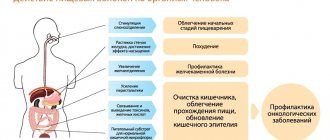How many calories are in a standard fast food lunch?
Let's say you order a lunch from a fast food establishment that consists of a salad, a sandwich, fries, and a shake. If we calculate the approximate calorie content of such a lunch, we get about 1500 kcal
. For people who lead a sedentary lifestyle, this calorie content can provide the daily calorie requirement. It's unlikely, but let's assume that this lunch will be your only meal of the day. Can we assume that everything is in order? From a calorie point of view, yes, but now let’s check what benefits your body received.
Almost half of the calorie content of such a lunch comes from fat, about 600 kcal
, this is more than the required daily amount of fat.
In addition, such a lunch will contain approximately half the safe daily allowance of salt
and approximately
double the allowance of sugar
.
Thus, your body received “shock doses” of sugar, salt and fat, but practically did not replenish its reserves of vitamins and microelements. The body will carefully save all the extra calories and hide them “for a rainy day,” converting them into fatty tissue, so don’t be surprised if the next weigh-in doesn’t make you happy.
How to reduce the amount of fast food you consume?
Quitting fast food is very difficult. After all, the products very quickly become addictive and addictive. One of the advantages of fast food is speed. Everyone is always in a hurry to get somewhere. And even during the lunch period, we do not agree to wait a long time for our dish. Therefore, a burger is the best option. To reduce your consumption of junk food, you should consult with your friends and choose the nearest cafe with quick order takeout. So, 15 minutes of waiting is a completely acceptable option.
You can also take lunch in a container with you. At home, you can prepare a healthy dish in advance - porridge, boiled chicken, baked fish. This will get rid of another “bad” habit - eating on the go. Eating should be associated with pleasant moments. So, it is better to have lunch in a pleasant company with cheerful conversations.
For snacks, you need to use a fruit or vegetable rather than a sandwich. The calorie content of one snack should not exceed kcal. This amount of calories is contained in 80 grams of chocolates and one whole, fresh pineapple. The second option will bring satiety for a long time, fill the body with all useful vitamins and microelements. The quality of food is an individual choice for everyone. But remember that the quality of life in general depends on this.
How much fat does a person need?
We cannot assume that fat is evil. The body needs fats just like proteins and carbohydrates, the question is the quantity. For the average city dweller who does not engage in back-breaking physical labor, 400 kcal
or
50 grams of fat per day
. This need can be satisfied in different ways: eat a few pieces of bread and butter, a small piece of lard or a large sausage. Not so much, considering that the matter is usually not limited to one sandwich.
In terms of calorie content, a standard burger will easily surpass a sandwich with sausage, and a multi-layer sandwich will cover about 30% of the daily calorie requirement. An average half-kilogram pizza with cheese, bought for a group, can satisfy a slight hunger, and eaten alone will cover more than half of the daily calorie requirement.
Why is it harmful to eat a lot of fat?
Not only people who are planning to lose weight should worry about excess fat, but also those who generally care about the condition of their body. This does not mean that fats need to be completely excluded from your diet, but you need to control their quantity and “quality”. To prepare high-calorie dishes in catering establishments, predominantly saturated animal fats
, which provoke the formation of cholesterol plaques, lead to hypertension and blockage of blood vessels, and place increased stress on the liver. But everything wouldn’t be so scary if only natural fats entered the body along with fast food.
In fast food, people want to eat not only nutritiously, but also inexpensively, so fast food establishments try to save on everything: on the interior, on dishes, on service and on the food itself. Cheaper substitutes for natural fats
.
They are dangerous mainly because they contain artificial trans fats
. The effect of trans fats on the human body has not been fully studied, but according to research results, trans fats can cause heart disease and also indirectly contribute to the development of cancer.
The permissible norm of trans fats is no more than 1% of the energy value of the entire diet, but in fast food dishes this norm can be exceeded tens of times. Here's an example of the calorie content of some popular fast food dishes:
.
Table from the site saharvnorme.ru
The main harm of fast food to the human body
Why is fast food so harmful? Of course, with its high energy value. The semi-finished product cannot be classified as a dietary product. It contains too much fat, calories and carbohydrates. And even with an active lifestyle, fast carbohydrates can lead to weight gain. In addition, fast carbohydrates are processed very quickly, and a feeling of hunger will appear within the first hour after eating.
High amount of cholesterol
Almost all fast foods (except frozen vegetables and fruits) contain a large amount of fat. After all, not the highest grade meat products are used for their production. For example, cutlets may contain ground skin, veins, and cartilage. Consequently, the level of saturated fat in the dish will be overestimated. A person runs the risk of increasing cholesterol levels in his body. And this threatens various diseases of the cardiovascular and endocrine systems.
Large amounts of salt
To eliminate taste defects, manufacturers add a huge amount of spices and salt. These ingredients perfectly mask the unpleasant taste and aroma. That’s why many of us love semi-finished products so much. But, excessive salt consumption provokes water retention in the human body. This is where swelling and kidney pathologies emerge. In addition, various flavorings irritate the walls of the digestive system. With regular consumption of fast food, a person's history will inevitably include colitis or gastritis.
Multiple E-shki
Almost all semi-finished products and fast foods contain glutamic acid - E 260, and its salts:
- E 261 - sodium glutamate;
- E 622 - potassium glutamate;
- E 624 - ammonium glutamate;
- E 625 - magnesium glutamate;
- E 623 - calcium diglutamate.
Due to these components, the sensitivity of taste buds increases. A person experiences increased salivation, which causes a huge appetite. Therefore, such food seems much tastier than my mother’s home-cooked food.
Excessive levels of glutamic acid in the human body lead to stimulation of the central nervous system. Vascular tone is also impaired. Such food is extremely dangerous for people with pathologies of the cardiovascular system and liver.
Fast food has too much salt and sugar
Fast food dishes are high in salt and sugar
. This is partly a marketing ploy; too much salt makes you thirsty, which means a person will definitely buy a drink for lunch. In addition, it is more difficult to recognize nuances of taste in salty food; this helps to hide “flaws” during the cooking process. But taste is everyone’s business; it is more important to understand the risks that a person faces when he regularly chooses to eat fast food instead of a nutritious, balanced meal.
Without salt, food seems bland and often tasteless, but consuming too much salt is also harmful. It has been proven that excess salt provokes the development of heart and kidney diseases.
, which can lead to
urolithiasis
. According to WHO, a person's daily diet should contain no more than 5 grams of salt, which is less than a teaspoon, although a safe dose would be half a teaspoon. If you look at how much salt fast food dishes contain, you can be sure that they more than cover all daily requirements. After a hearty fast food lunch, your body will have more than enough salt, although not only salt, but also sugar.
In fast food establishments you are unlikely to find tea, coffee or even plain water on the menu; you will be actively offered sweet carbonated drinks
or
milkshakes
. It is difficult to quench your thirst with such drinks, but it is easy to gain extra pounds, and possibly diabetes. It is enough for an adult to eat 4-6 teaspoons of sugar per day, and for men the permissible norm of sugar is higher, and for children it is much lower (1 teaspoon is enough for them). What is taken into account is not only the sugar that a person consumes in the form of granulated sugar, but also that contained in the products themselves, no matter whether it is natural sugar or artificially added.
Thus, one can of sweet carbonated water contains approximately 6.5 teaspoons of sugar, which already exceeds the permissible sugar limit even for an adult man. A standard serving of ice cream will add about 3.5 tablespoons of sugar, as well as sauces and sandwiches, which are also often usually prepared with added sugar. Such a “sweet life” will definitely affect your waistline, and can also cause pancreatic diseases. See how many calories are in popular fast food drinks
.
Table from the site saharvnorme.ru
Is one portion of fast food enough for you?
One of the features of “fast food” is that it gives you a quick feeling of fullness. This happens due to fast carbohydrates
, which are found in large quantities in sandwich buns and French fries. Such food is rich in fats, but poor in fiber. Simply put, one serving of fast food will quickly fill you up, and glucose will instantly enter your bloodstream, but the “euphoria” will quickly pass. Within a couple of hours, your glucose levels will drop again and you will feel hungry. If at this time you have not yet gone far from the saving fast food, then with a high degree of probability you will pay for a second portion of the same fast carbohydrates.
Fast food establishments are gradually teaching people to eat more, and larger portions
. Even a standard portion of food in such an establishment will be significantly larger and higher in calories than needed for a single meal. Multi-layer burgers, “meter-long” sandwiches, thick-crust pizza. Heavily breaded nuggets, oil-soaked fries, a large glass of soda water, and a scoop of ice cream for dessert add up to hundreds of calories. Even one sausage is more processed meat than is safe to consume in a day. But marketers make sure that even such a portion is not enough for guests of the establishment, so they offer all kinds of profitable sets, “double” or “XXL” portions. In pursuit of profit, buyers are willing to eat more than they originally intended.
Nutritional value of fast food
Fast food is a very high-calorie food, but another disadvantage of fast food is that it does not contain enough nutrients
. You can “fill your stomach” with fast food, but you won’t be able to provide the body with the necessary amount of proteins and vitamins. In terms of calorie content, a lunch at a fast food chain can almost completely exceed the recommended daily calorie intake, but at the same time, the body’s need for vitamins will be satisfied by no more than 20-30%.
Deficiency of vitamins and microelements provokes the development of various diseases and disrupts metabolism. Fats will settle on the walls of blood vessels and form cholesterol plaques, which contributes to the development of atherosclerosis
. An excess of salt affects the water-salt balance of the body, and ultimately the functioning of the kidneys. Sugar leads to the development of diabetes due to disorders of the thyroid gland. Spenders can increase the risk of developing cancer. This is not a complete list of possible negative consequences caused by frequent visits to fast food establishments.
You need to remember that fast food is a quick snack option, so you can resort to it only in extreme cases. Food in fast food establishments is too salty, sweet and fatty, it contains a lot of fast carbohydrates, but almost no vitamins and beneficial microelements. You can allow yourself occasional snacks in fast foods, but this should not become a habit, otherwise you will earn not only extra pounds, but also a whole “bouquet” of other diseases. The effect will be “cumulative”, you are unlikely to notice a sharp deterioration in your health, but the consequences can be extremely severe. Fast food is especially dangerous for children, since their bodies especially need a balanced diet to ensure growth and development. In addition, children quickly get used to “junk food”, so it is much more difficult to force them later to eat healthier, but less tasty food.
A little about fast food
The history of fast food dates back to the times of Ancient Rome. It was then that small eateries began to appear, selling inexpensive and simple, but hot food: bread, meat, peas, various pastries, flatbreads, etc.
In the 1940s, the enterprising Americans the McDonald brothers opened the first fast food restaurant. Today, McDonald's is one of the world's largest food service corporations.
Fast food includes the following products that are not prepared at home:
- pizza;
- hamburger;
- cheeseburger;
- French fries;
- shawarma;
- cheburek;
- noodles and mashed potatoes;
- snacks are light dishes intended for snacking.
The main principle of such dishes is quick preparation, which is one of their few advantages.











